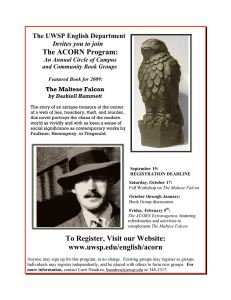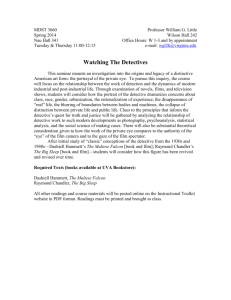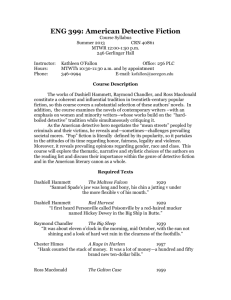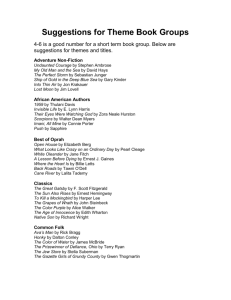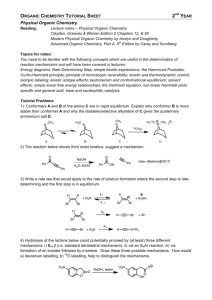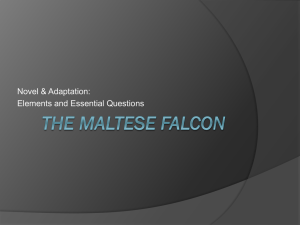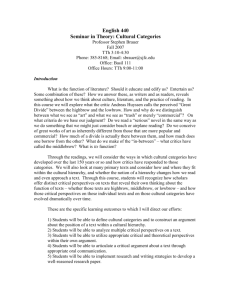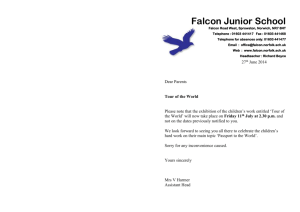Document 12003741
advertisement
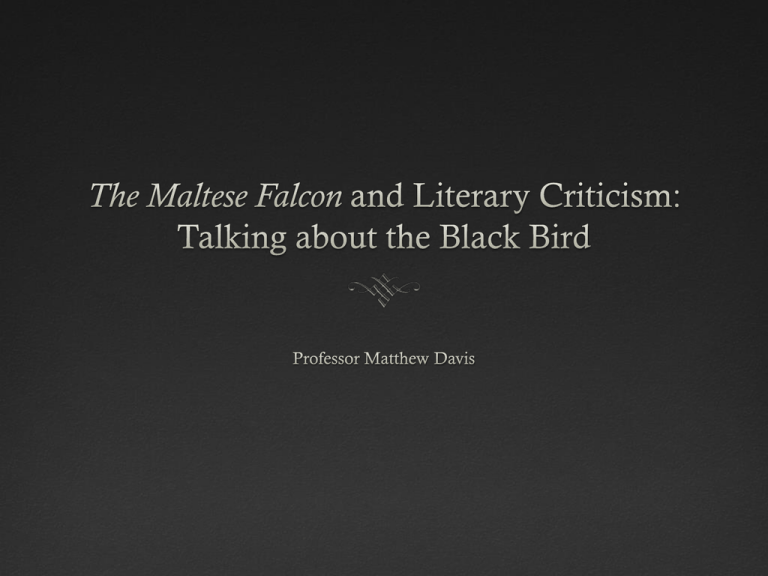
Samuel Dashiell Hammett 1894-1961 Novels Red Harvest (1929) The Dain Curse (1929) The Maltese Falcon (1930) The Glass Key (1931) Woman in the Dark (1933) The Thin Man (1934) 1934 Modern Library Edition Critical Response • David T. Bazelon, “Dashiell Hammett’s Private Eye: No Loyalty Beyond the Job” (1949) Critical Response • David T. Bazelon, “Dashiell Hammett’s Private Eye: No Loyalty Beyond the Job” (1949) • Edmund Wilson in The New Yorker (October 1940): Still fearing that I might be unjust to a department of literature that seemed to be found so absorbing by many, I went back and read The Maltese Falcon [. . .] it was difficult for me to understand what they had thought—in 1930—they were toasting. The Maltese Falcon today seems not much above those newspaper picture-strips in which you follow from day to day the ups and downs of a strong jawed hero and a hardboiled but beautiful adventuress. 1950s Critical silence and misunderstanding of Hammett’s work. 1950s Critical silence and misunderstanding of Hammett’s work. Largely due to: •Politics: Hammett’s association with the Communist Party hurt his critical reputation in the academy 1950s Critical silence and misunderstanding of Hammett’s work. Largely due to: •Politics: Hammett’s association with the Communist Party hurt his critical reputation in the academy •Aesthetics: Genre fiction was widely dismissed in critical assessments of American literature 1960s Change in reception of Hammett’s work. Largely due to: 1960s Change in reception of Hammett’s work. Largely due to: •Knopf ’s resetting of The Complete Dashiell Hammett and its republication in 1865 as The Novels of Dashiell Hammett. 1960s and •Random House’s 1966 publication of The Big Knockover, a collection of ten tales, including his unfinished Tulip. 1960s Critical renaissance in Hammett studies 1968: David Madden’s Tough Guy Writers of the Thirties Irving Malin’s “Focus on The Maltese Falcon: The Metaphysical Falcon” Robert Edenbaum’s “The Poetics of the Private Eye: The Novels of Dashiell Hammett” 1970s George J. Thompson’s “The Problem of Moral Vision in Dashiell Hammett’s Detective Novels” serially in The Armchair Detective. 1970s George J. Thompson’s “The Problem of Moral Vision in Dashiell Hammett’s Detective Novels” serially in The Armchair Detective. • Appeared between 1972 and 1974 1970s George J. Thompson’s “The Problem of Moral Vision in Dashiell Hammett’s Detective Novels” serially in The Armchair Detective. • Appeared between 1972 and 1974 • Traced Hammett’s artistic vision from Red Harvest to The Thin Man 1970s George J. Thompson’s “The Problem of Moral Vision in Dashiell Hammett’s Detective Novels” serially in The Armchair Detective. • Appeared between 1972 and 1974 • Traced Hammett’s artistic vision from Red Harvest to The Thin Man • Engaged the work of other critics 1970s George J. Thompson’s “The Problem of Moral Vision in Dashiell Hammett’s Detective Novels” serially in The Armchair Detective. • Appeared between 1972 and 1974 • Traced Hammett’s artistic vision from Red Harvest to The Thin Man • Engaged the work of other critics • Addressed both the text and critical discourse about the text 1970s George J. Thompson’s “The Problem of Moral Vision in Dashiell Hammett’s Detective Novels” serially in The Armchair Detective. • Appeared between 1972 and 1974 • Traced Hammett’s artistic vision from Red Harvest to The Thin Man • Engaged the work of other critics • Addressed both the text and critical discourse about the text • Saw “no ambiguity” in Spade’s final confrontation with Brigid 1970s George J. Thompson’s “The Problem of Moral Vision in Dashiell Hammett’s Detective Novels” serially in The Armchair Detective. • Appeared between 1972 and 1974 • Traced Hammett’s artistic vision from Red Harvest to The Thin Man • Engaged the work of other critics • Addressed both the text and critical discourse about the text • Saw “no ambiguity” in Spade’s final confrontation with Brigid • Made the case for seeing Spade in heroic terms 1970s George Grella’s “The Wings of the Falcon and the Maltese Dove” (1976) Frederick Burelbach’s “Symbolic Naming in The Maltese Falcon” (1979) 1970s Steven Marcus’s “Dashiell Hammett and the Continental Op” in Partisan Review (1974) 1970s Steven Marcus’s “Dashiell Hammett and the Continental Op” in Partisan Review (1974) Emphasized significance of Flitcraft parable to understanding Hammett’s work: 1970s Steven Marcus’s “Dashiell Hammett and the Continental Op” in Partisan Review (1974) Emphasized significance of Flitcraft parable to understanding Hammett’s work: • Scene as “the most important or central moment in the entire novel” but also as “one of the central moments in all of Hammett’s writing” 1970s Steven Marcus’s “Dashiell Hammett and the Continental Op” in Partisan Review (1974) Emphasized significance of Flitcraft parable to understanding Hammett’s work: • Scene as “the most important or central moment in the entire novel” but also as “one of the central moments in all of Hammett’s writing” • Saw it as an existential drama about “the ethical unintelligibility of the world” and in doing so enabled a transformation from genre in “the direction of literature” 1980s Three major biographies: 1980s Three major biographies: • Richard Layman’s Shadow Man: The Life of Dashiell Hammett (1981) • William F. Nolan’s Hammett: A Life at the Edge (1983) • Diane Johnson’s Dashiell Hammett, a Life (1983) 1980s Three major biographies: • Richard Layman’s Shadow Man: The Life of Dashiell Hammett (1981) • William F. Nolan’s Hammett: A Life at the Edge (1983) • Diane Johnson’s Dashiell Hammett, a Life (1983) Five book-length studies: 1980s Three major biographies: • Richard Layman’s Shadow Man: The Life of Dashiell Hammett (1981) • William F. Nolan’s Hammett: A Life at the Edge (1983) • Diane Johnson’s Dashiell Hammett, a Life (1983) Five book-length studies: • Peter Wolfe’s Wood Beams Falling: The Art of Dashiell Hammett (1980) • Willaim Marling’s Dashiell Hammett (1983) • Dennis Dooley’s Dashiell Hammett (1984) • Julian Symon’s Dashiell Hammett (1985) • Sinda Gregory’s Private Investigations: The Novels of Dashiell Hammett (1985) 1980s Critical Foci: 1. Ambiguity 1980s Critical Foci: 1. Ambiguity Gregory reads Hammett’s work as “declaration of the omnipresence of mystery and the failure of human effort (on the part of both the reader and the detective) to ever dispel it” and examines his distanced thirdperson point of view as an attempt to “underscore the mystery surrounding the detective” 1980s Critical Foci: 2. Politics 1980s Critical Foci: 2. Politics Robert Shulman in “Dashiell Hammett’s Social Vision” (1985) insists that Hammett’s work “carries a concealed social message” that “brings alive the conflicting versions of individualism that society emphasizes” 1980s Critical Foci: 3. Economics 1980s Critical Foci: 3. Economics William Marling in “The Style and Ideology of The Maltese Falcon” (1989) argues that a more informed evaluation of the novel would try to recover a “cluster of emerging design values and economic forms” that permeate the text and would allow us to see Sam Spade as “an art nouveau detective” and “a new hero for new readers in a new era” 1990s Increasingly sophisticated analyses of the novel: 1990s Increasingly sophisticated analyses of the novel: • Jasmine Young Hall’s “Jameson, Genre, and Gumshoes: The Maltese Falcon as inverted Romance” (1990) 1990s Increasingly sophisticated analyses of the novel: • Jasmine Young Hall’s “Jameson, Genre, and Gumshoes: The Maltese Falcon as inverted Romance” (1990) • Peter J. Rabinowitz’s “‘How Did You Know He Licked His Lips’: Second Person Knowledge and First Person Power in The Maltese Falcon” (1994) 1990s Increasingly sophisticated analyses of the novel: • Jasmine Young Hall’s “Jameson, Genre, and Gumshoes: The Maltese Falcon as inverted Romance” (1990) • Peter J. Rabinowitz’s “‘How Did You Know He Licked His Lips’: Second Person Knowledge and First Person Power in The Maltese Falcon” (1994) • Mark McGurl’s “Making ‘Literature’ of It: Hammett and High Culture” (1997) Twenty-First Century Two important books by Richard Layman make the case for The Maltese Falcon as a great American novel: Twenty-First Century Two important books by Richard Layman make the case for The Maltese Falcon as a great American novel: • The Maltese Falcon (2000), volume 3 of the Literary Masterpieces series Twenty-First Century Two important books by Richard Layman make the case for The Maltese Falcon as a great American novel: • The Maltese Falcon (2000), volume 3 of the Literary Masterpieces series • Dashiell Hammett’s The Maltese Falcon: A Documentary Volume (2003), an extensive collection of hard-to-find material including previously unknown reviews, correspondence, sales figures, book covers, news articles, and critical essays Further Avenues of Inquiry Further Avenues of Inquiry • Genre Studies: The Maltese Falcon and Hard-Boiled Detective Fiction Further Avenues of Inquiry • Genre Studies: The Maltese Falcon and Hard-Boiled Detective Fiction • Historical Approaches: The Maltese Falcon and the American 1930s Further Avenues of Inquiry • Genre Studies: The Maltese Falcon and Hard-Boiled Detective Fiction • Historical Approaches: The Maltese Falcon and the American 1930s • Philosophical Approaches: The Flitcraft Parable and Moral Responsibility Further Avenues of Inquiry • Genre Studies: The Maltese Falcon and Hard-Boiled Detective Fiction • Historical Approaches: The Maltese Falcon and the American 1930s • Philosophical Approaches: The Flitcraft Parable and Moral Responsibility • Gender Studies: Sam Spade and the Hard Boiled Masculine Further Avenues of Inquiry • Genre Studies: The Maltese Falcon and Hard-Boiled Detective Fiction • Historical Approaches: The Maltese Falcon and the American 1930s • Philosophical Approaches: The Flitcraft Parable and Moral Responsibility • Gender Studies: Sam Spade and the Hard Boiled Masculine • Economic Concerns: The Maltese Falcon and the Gold Standard
